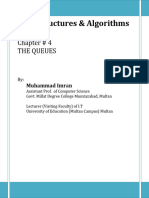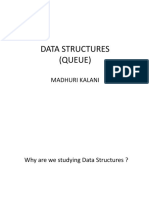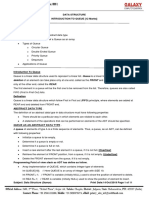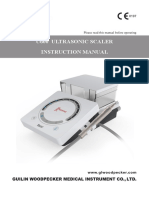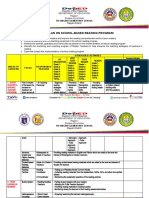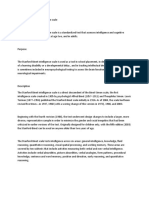Queue Data Strutures
Introduction to Queue Data Structures:
Queue is a linear data structure where the data is inserted from one end
called Rear and the deleted from the other end called as Front.
Front points to the beginning of the Queue and rear points to the end of
the queue.
In queue data structure, the insertion and deletion operations are
performed based on FIFO (First In First Out) principle.
According to its FIFO structure , data inserted first will also be removed
first.
In a queue data structure, the insertion operation is performed using a
function called "enQueue()" and deletion operation is performed using
a function called "deQueue()".
Example
Queue after inserting 25, 30, 51, 60 and 85.
www.vectorindia.org 1
� Queue Data Strutures
Operations on a Queue
The following operations are performed on a queue data structure...
1. enQueue(value) - (To insert an element into the queue)
2. deQueue() - (To delete an element from the queue)
3. display() - (To display the elements of the queue)
Queue data structure can be implemented in two ways. They are as follows...
1. Using Array
2. Using Linked List
When a queue is implemented using an array, that queue can organize an
only limited number of elements. When a queue is implemented using a
linked list, that queue can organize an unlimited number of elements.
Algorithm for Enqueue Operation:
• check if the queue is full
• if the queue is full, produce overflow error and return
• if the queue is not full for the first element, set value of FRONT to 0
• increase the REAR index by 1
• add the new element in the position pointed to by REAR
Algorithm for Dequeue Operation
• check if the queue is empty
• If the queue is empty , produce the underflow error and return.
• If queue is not empty , return the value pointed by FRONT and
increase the FRONT index by 1
• for the last element, reset the values of FRONT and REAR to -1
www.vectorindia.org 2
� Queue Data Strutures
www.vectorindia.org 3
� Queue Data Strutures
Applications of Queue
Queue, as the name suggests is used whenever we need to manage any
group of
objects in an order in which the first one coming in, also gets out first while
the others wait for their turn, like in the following scenarios:
• CPU scheduling, Disk Scheduling
• When data is transferred asynchronously between two processes.The
queue is used for synchronization. eg: IO Buffers, pipes, file IO, etc
• Handling of interrupts in real-time systems.
• Call Center phone systems use Queues to hold people calling them in
an order
Complexity Analysis of Queue Operations:
Just like Stack, in case of a Queue too, we know exactly, on which position
new element will be added and from where an element will be removed,
hence both these operations requires a single step.
Enqueue: O(1)
Dequeue: O(1)
Size: O(1)
Types of Queue:
1. Simple Queue
2. Circular Queue
3. Priority Queue
Simple Queue
In a simple queue, insertion takes place at the rear and removal occurs at
the front. It strictly follows FIFO rule.
www.vectorindia.org 4
� Queue Data Strutures
Circular Queue
In a circular queue, the last element points to the first element making a
circular link.
The main advantage of a circular queue over a simple queue is better
memory utilization. If the last position is full and the first position is empty
then, an element can be inserted in the first position. This action is not
possible in a simple queue.
Priority Queue
A priority queue is a special type of queue in which each element is
associated with a priority and is served according to its priority. If elements
with the same priority occur, they are served according to their order in the
queue.
www.vectorindia.org 5
� Queue Data Strutures
Insertion occurs based on the arrival of the values and removal occurs based
on priority.
Deque (Double Ended Queue)
Double Ended Queue is a type of queue in which insertion and removal of
elements can be performed from either from the front or rear. Thus, it does
not follow FIFO rule (First In First Out).
www.vectorindia.org 6
� Queue Data Strutures
Note :
Reference Books : Taken contents and diagrams from various websites.
www.vectorindia.org 7












































